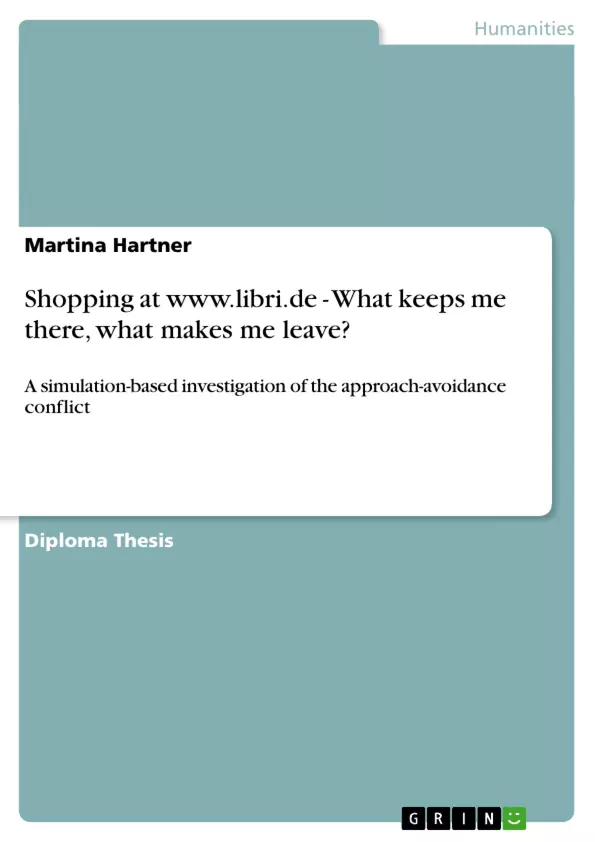Different motivation tendencies, aspirations and fears connected to the same action quite often happen to contradict each other. A person looks at the positive (= approaching) and negative (= avoiding) sides when aiming towards a goal or reaching a decision. For example, on the one hand a student wants to go swimming, as it is a nice warm summer day, but on the other hand the student should be studying for his upcoming exam. The student undergoes a conflict about what to do. The following work is based on this special kind of conflict called approach-avoidance conflict. In consumer behaviour literature (cf. Solomon, Bamossy, & Askegaard, 2001), this conflict is often mentioned regarding the general decision of whether or not a certain
product will be bought. Positive as well as negative aspects of the product are judged and weighted when reaching a decision. Thus, it is assumed that this kind of conflict also occurs in the context of online shopping. Online shopping has both positive as well as negative aspects. It encompasses approaching (where beneficial rewards are expected) and avoiding tendencies (where harmful rewards are expected). In the context of online shopping, the approach tendency could be for example the convenience of shopping from home. It is possible to get a book ordered and delivered without even leaving the house. At
the same time, potential online shoppers might worry about credit card fraud if payment is demanded by credit card. The latter would represent the avoidance tendency. Both tendencies are competing against each other. Which one is stronger? The consumer has to make a choice because the person cannot shop online to benefit from the convenience and at the same time not shop online to avoid possible credit card fraud. The two responses are
incompatible.
Inhaltsverzeichnis (Table of Contents)
- I. Introduction and Overview of Thesis
- II. Theoretical Analysis
- 1 Scientific Context of Approach-Avoidance Conflict Model
- 1.1 Behaviourism embedding Approach-Avoidance Conflict Model
- 1.2 Reflection of Behaviourism in the Context of Online Shopping
- 2 Theory of Approach-Avoidance-Conflict
- 2.1 Miller's Conflict Model
- 2.2 Critics and further Development of Miller's Assumptions
- 2.3 Approach and Avoidance Motivation in Personality
- 2.4 Summary of Approach-Avoidance Conflict Model
- 3 Introduction into Online Shopping
- 3.1 Penetration of E-Commerce and Online Shopping
- 3.2 Online Shopping - a Part of E-Commerce
- 3.3 Typology of Online Shoppers
- 4 Approach-Avoidance Conflict in Online Shopping Situation
- 4.1 Perceived Customer Value
- 4.1.1 Costs saving
- 4.1.2 Time Saving
- 4.1.3 Convenience
- 4.2 User Interface
- 4.2.1 Davis' Technology Acceptance Model
- 4.2.2 Effective Website Design
- 4.3 Risk Perception
- 4.3.1 Product Performance Risk
- 4.3.2 Financial Risk
- 4.3.3 Psychological Risk
- 4.3.4 Time Risk
- 4.3.5 Social Risk
- 4.3.6 Physical Risk
- 4.4 Summary of Approach-Avoidance Conflict when Online Shopping
- 4.1 Perceived Customer Value
- 1 Scientific Context of Approach-Avoidance Conflict Model
- III. Empirical Analysis
- 5 Research Question and Hypotheses
- 5.1 Research Question
- 5.2 Hypotheses
- 6 Pre-Test
- 6.1 Aims of Pre-Test
- 6.2 Results of Pre-Test
- 7 Online Simulation
- 7.1 Method of Simulation
- 7.1.1 Participants
- 7.1.2 Instrument
- 7.1.3 Realisation
- 7.2 Results of Simulation
- 7.2.1 Descriptive Data Analysis
- 7.2.2 Testing of Hypotheses
- 7.2.3 Explorative Data Analysis
- 7.1 Method of Simulation
- 8 Reflection of Method and Discussion of Results
- 8.1 Reflection of Method
- 8.2 Discussion of Results
- 5 Research Question and Hypotheses
- IV. Summary
- V. Bibliography
- VI. Appendices
- Appendix A – Tables
- Appendix B - Instrument Pre-Test
- Appendix C - Instrument Simulation
- Appendix D - Raw Data
Zielsetzung und Themenschwerpunkte (Objectives and Key Themes)
The primary objective of this thesis is to investigate the approach-avoidance conflict in the context of online shopping. It analyzes the factors that motivate consumers to engage in online shopping and those that deter them, using a simulation-based approach. The study explores the theoretical framework of approach-avoidance conflict and its application to online shopping behavior. Key themes explored in the text include:- The approach-avoidance conflict model and its relevance to consumer behavior.
- The influence of perceived customer value, user interface, and risk perception on online shopping decisions.
- The application of simulation techniques to study consumer behavior in online environments.
- The interplay between theoretical frameworks and empirical data analysis in understanding online shopping dynamics.
Zusammenfassung der Kapitel (Chapter Summaries)
This thesis begins with an introduction that outlines the research question and hypotheses. It establishes the theoretical framework by examining the approach-avoidance conflict model and its historical development within behaviorism. Chapter 3 introduces the concept of online shopping, discussing its rise within the broader context of e-commerce and analyzing different shopper types. Chapter 4 then delves into the specific application of the approach-avoidance conflict model to online shopping situations. It focuses on key factors such as perceived customer value, user interface design, and risk perception. The study proceeds to the empirical analysis, including a pre-test phase and a simulation study. The results of these analyses are presented and discussed, focusing on both the confirmation of hypotheses and the emergence of new insights.Schlüsselwörter (Keywords)
This thesis primarily focuses on the concepts of approach-avoidance conflict, consumer behavior, electronic commerce, online shopping, simulation, and regression analysis. These key terms represent the central themes and methodological approaches employed throughout the study. The work draws upon existing theoretical frameworks and utilizes empirical data collected through a simulation experiment to analyze the motivations and barriers influencing online shopping decisions.- Quote paper
- Mag. Martina Hartner (Author), 2005, Shopping at www.libri.de - What keeps me there, what makes me leave?, Munich, GRIN Verlag, https://www.grin.com/document/120238



